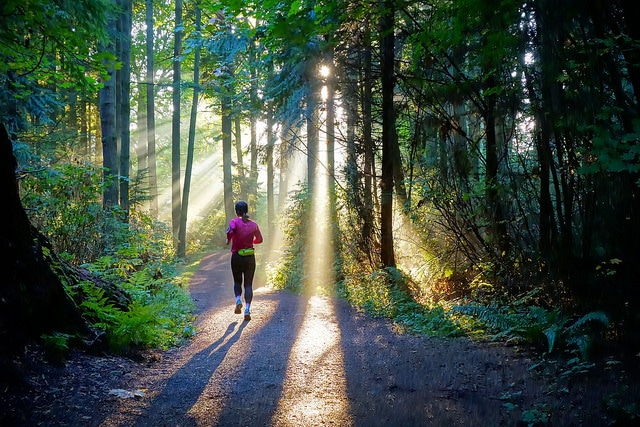
Are you looking to take your running to the next level?
Looking for a good way to mix your running workouts and add a new challenge and twist to your training program?
Or are you just bored with your regular running routine?
Then why not give trail running a try and be one with nature. The fact is, trail running is awesome, and its physical and mental benefits are—beyond the shadow of a doubt—undeniable.
Therefore, if you have a been a consistent “city”, on-road kinda of a runner, and are thinking about heading off to the beaten track, then keep on reading.
Trail running is simple, but taking your first few steps can be really intimidating. But fret no more. This awesome guide will teach you how to start trail running right, avoid injury or burnout, stay safe for the long haul and make the most out of every trail workout you do.
So are you ready to discover the wild soothing side of running?
Then here we go…
Trail Running Demystified
So what’s trail running all about?
In layman’s terms, trail running involves running on anything that is unpaved and/or natural, mostly taking place on softer, more cushioned surfaces like dirt paths and grass.
In most cases, a good trail should (1) offer natural obstacles (think roots and rocks, etc.), (2) be unpaved (preferably natural), (3) provide great scenery (away from the hustle and bustle of the city), and (4) consist of drastic elevation gain (lots of ascents and descents).
Therefore, as long as a trail fulfills these four conditions, you might be on the right (trail) path.
By the same token, going for a run in the park or around the local forest might be qualified as a trail workout. In fact, a good trail could be as simple as running on grass, a bike course, dirt and or a sand path.
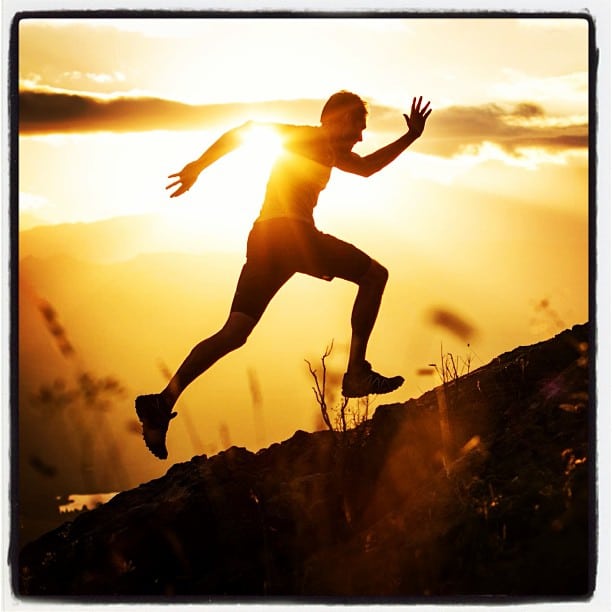
Image Credit – Darren Smith via Flickr
The Benefits of Trail Running
Trail running will have you hopping over rocks and roots, but its benefits are well worth the effort.
Here are some of the benefits that you stand to gain from hitting the trails:
Less Risk of injury. When trail running is done right, it can help you reduce the risk of injury while making you a more efficient and stronger runner in the process.
Why? The reason is simple. Trail running offers surfaces that you are typically much softer, especially in contrast with pavement. In fact, study shows that running on hard surfaces might lead to an increased risk of overuse injury.
Plus, trails also reduce the risk of overuse injury by forcing your body to recruit different stabilizing muscles in the hips and the lower legs—unlike road running where you have to apply the same muscles movement and stress the same body parts and ligaments over and over—reducing the risk of the onset of an overuse injury.
More challenge. Trail running offers a broad range of challenges that you will need to overcome, including steep hills to climb (or walk, and hike), the technical terrain to negotiate and navigate. All of these challenges can help you build more muscles in your hips and lower legs as you have to work extra harder to keep your body stable and under control on different terrains and surfaces.
Burns more calories. In fact, according to research, trail running can burn up roughly 10 percent more calories than road running. 10 percent might not seem as much but keep in mind that it does add up. And that might be the exact edge you need with your weight loss goals.
Improves balance and coordination. Running on the unpredictable and uneven terrains engage the smaller, intrinsic “helper” muscle groups—especially in the hips and core—resulting in better stabilization and improved balance and coordination.
Makes you feel like a real runner. This is the ultimate advantage to trail running if you ask me. To be good at trail running, you will have to become good at all sorts of running and learn how to be in tune with your body by running on feel.
Gets you into nature. Well, to be honest, this is maybe the biggest reason I love trail running so much. Trail running will get you out there in nature and into the countryside, fully experiencing the beauty of nature, leaving the hustle and bustle and the pollutants of urban living behind.
The Bad News
As you can see from the list above, trail running has a lot to offer. Nonetheless, I know many of a runner that wouldn’t be seen dead in the trails.
Why?
To be honest, trail running has a dark side, and if you are not aware of, you might get yourself into trouble.
The fact is, venturing into the wilderness comes with a lot of obstacles, such as steep ascents and descents, jagged terrains, shifty spots in the sands, branches sticking out of the ground, low hanging trees, jarring rocks and roots, and God knows what type of wildlife (and other dangers) might be lurking in the shadows.
So it’s not a 100 percent safe activity—and truth be told, there is a certain degree of risk involved with doing any type of an outdoor sport.
Nonetheless, there is a silver lining here.
In fact, there are a few measures you can take to reduce the risks and ensure a safe and comfortable trail running experience.
1. Find a Trail—or Blaze One
Before you head out the door, you will have to, of course, find the right trail.
Picking the right trial, can either make or break your trail running routine. In other words, start with the wrong trail, and you might end up injured, bummed out and disappointed.
As I have already stated in the definition section, trail running is usually described as any sort of running taking place off-road or pavement, but that doesn’t mean that you need to trek into a deep, dark, isolated forest nor tackle a rocky, steep path riddled with natural obstacles to start trail running.
The fact is when you are just starting out, any trail will do—even the easiest of all trails. A good trail can include a wide variety of off-road, unpaved surfaces, ranging from footpath found in mountains to bike paths and so on.
The good news is, regardless of where you live, you can always find a trail that fits with your current fitness level.
Thus, seek out an easy, short, and relatively flat route to start your trail running routine, and as you get stronger, up the ante by expanding your trail adventures into longer, more technical terrains.
There are a few ways to find trails near your home. For starters, make sure to connect with local running stores, national parks, forest preserves, and of course, social networking sites and Google. Or just go to Trails.com for local off-road routes and most popular trail adventures in your area.
2. Start Slow
Trail running can tire you out a lot faster than on-road running—whether you are a newbie or a veteran runner.
Consequently, your first few trail runs should be performed at a moderate pace—probably at a conversational and easy pace, aiming for no more than 60 to 70 percent of your maximum heart rate and running by your effort level and the tune of your body.
If you have never done any trail running before and/or an overall beginner runner, then I urge you to get started on an easy flat surface, maybe with a 20 to 30 minutes cross-country run in a nearby park that offers a little bit of elevation gain and easy obstacles.
Starting this way is much safer because, first of all, you won’t have to worry getting lost. Secondly, you will still be close to “home base” and/or be around other people in the off chance something goes wrong.
As you log in more trail workouts, aim to increase your distance and/or time by no more than 10 percent from one week to the next.
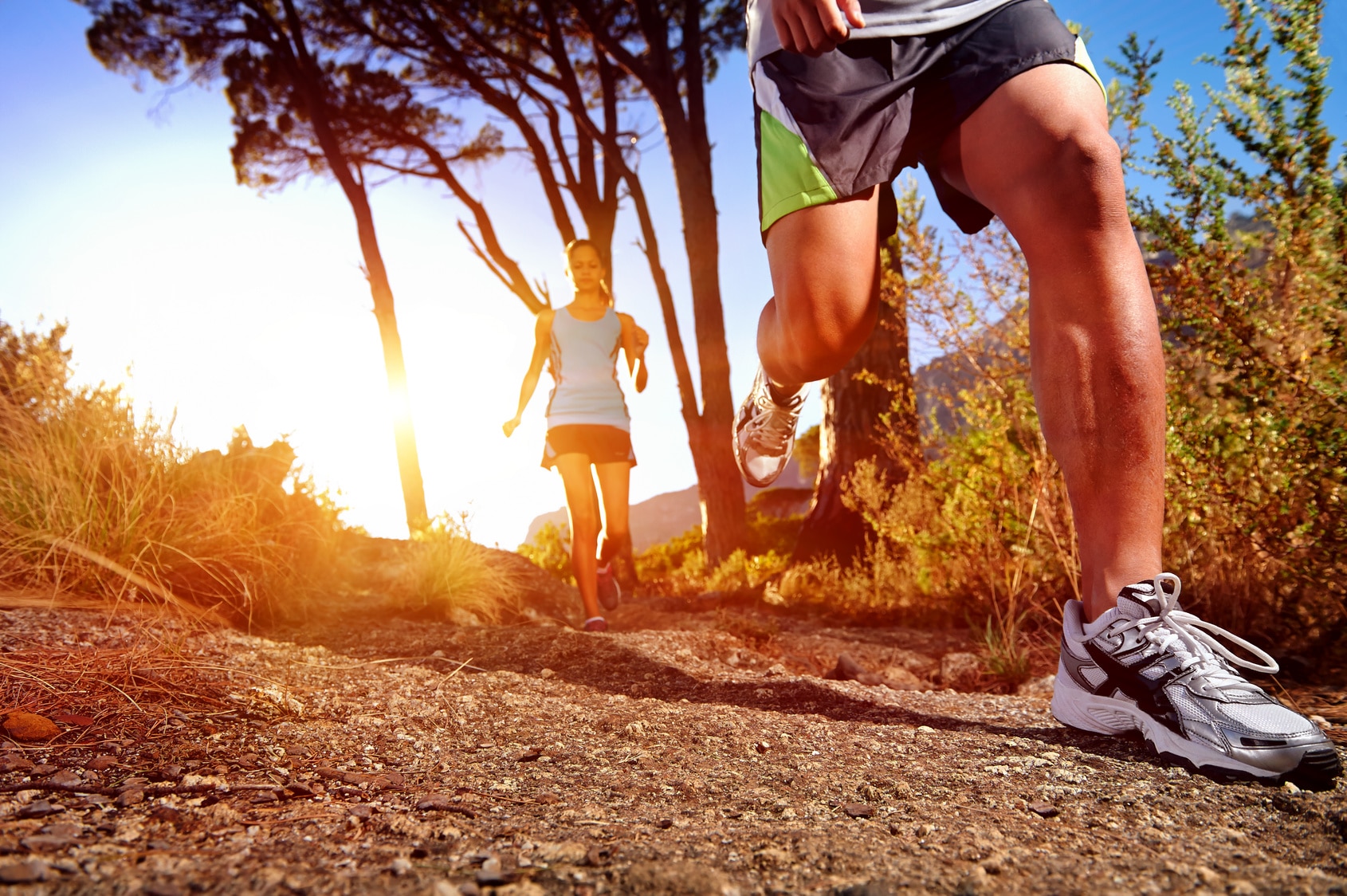
I hate to break it to you, but the truth is, even if you are an experienced runner, you need to slow down on the trails.
In fact, according to the Trail Running magazine, you can expect to run 10 to 20 percent slower on trails than when running on flat easy surfaces.
Why?
It’s actually quite simple. On the trails, you are more likely to come face to face with many challenges, including steeper hills, technical single-track trails with lots of unstable rocks and roots to negotiate, and plenty of other challenges to deal with.
Therefore, expect your average pace per mile to slow down for at least one to two minutes—or even more on rough technical terrain—than you would when running on flat, non-technical surfaces.
For example, if a 5-mile run on pavement usually takes you, say, 50 minutes, the same distance on the trails might take you more than an hour to complete.
Of course, as you get good at tackling trails, you will gradually build your confidence, running power, and the proper footing needed to speed things up. But that takes time.
4. Get the Right Shoes
Road shoes will do the trick for short trail runs. But if you decided to make trail running a part and parcel of your life, you will, sooner or later, be in want of a pair of appropriate trail shoes.
By investing in a good trail pair, you will be protecting your feet from all sorts of trouble, including stubbed toes, bruised feet, slippery falls, sprained ankles and overuse injury.
Trail running shoes differ from road shoes in that they are typically made from tougher materials, and are designed to endure the extra wear and tear of tough and sharp terrain. Plus, these shoes offer a greater stability and stronger, protective sole than most road shoes.
What’s more? Some of these shoes are designed with rugged treads that offer more traction on slippery, muddy trails, leading to a stronger grip on slippery and rocky terrains.
However, I don’t think you should let not having a trail pair (or other trail items) hold you back from heading into the wasteland. Hence, there is no need to rush into a buying decision, and in some cases, you might need to log in a few easy trail runs before you make the investment.
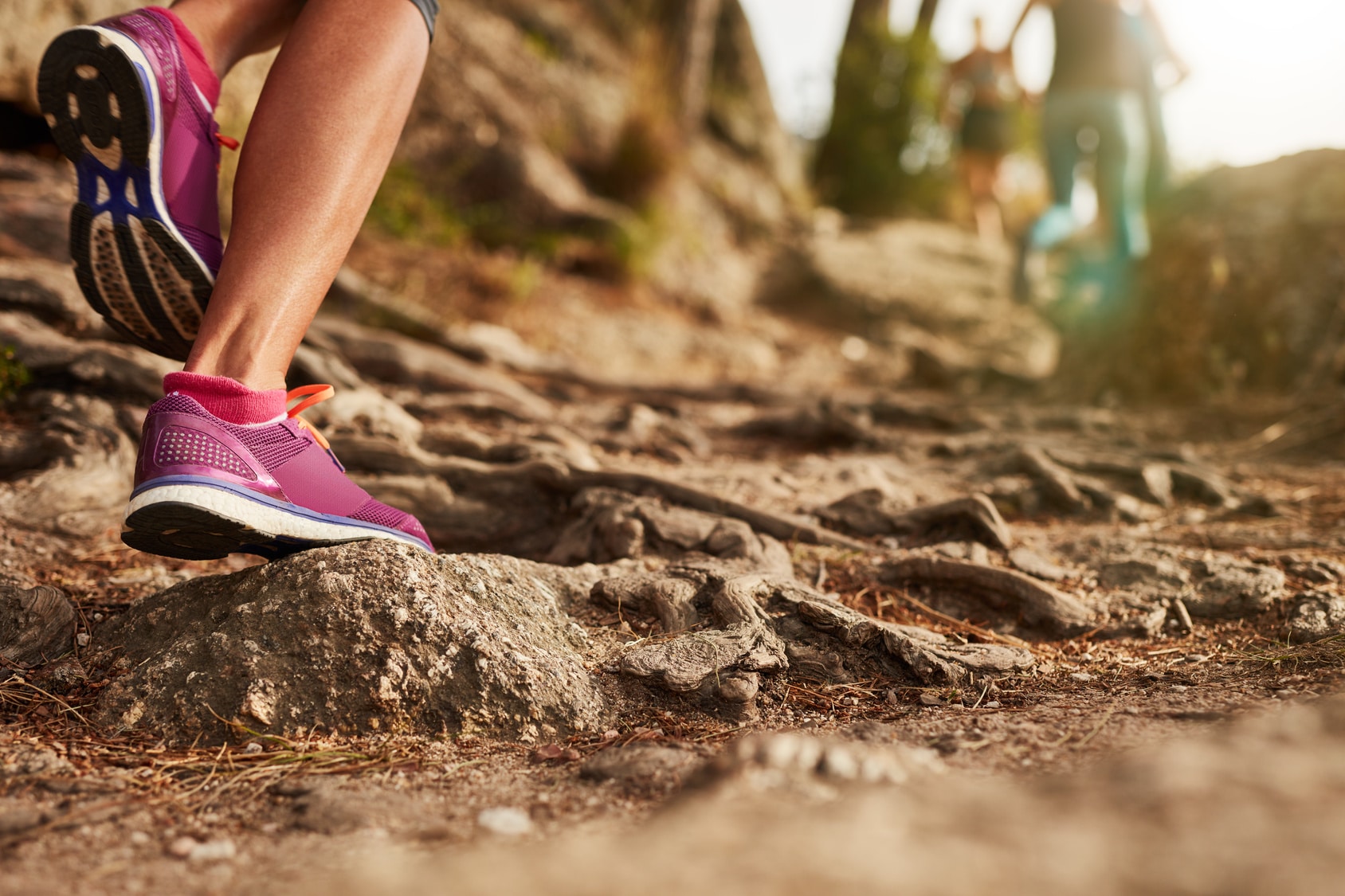
Running is, still, one of the most convenient of all sport.
Nonetheless, to make the most out of every trail workout, I think you still need some basic essentials to ensure a safe and comfortable run.
Here are a few basic essentials for trail running:
For clothing, opt for the same technical clothing that you wear on your daily runs—mainly clothing made from synthetic, moisture wicking fabric instead of cotton, which retains humidity and once it’s wet, tends to stay wet, leading to all sort of chaffing and discomfort.
Nonetheless, I might suggest that you consider going for something that you don’t mind getting wet, soiled, muddy or torn and ripped by branches or bushes. I promise it will.
You will also need some sort of insect repellent, such as a bug spray, to protect you against insect bites and ticks. This, of course, is dependent on where and when you are running.
You can also get a pair of gaiters to guard your feet and shoes from the elements. And if you are going to do any sort of trail running when it’s dark—whether at dawn or late in the evening, you might need a flashlight or a headlamp to ensure good visibility and safety.
Other essential trail running items you might consider investing in include a hat, sunglasses, sunscreen, lip balm, a hydration system, peppy spray, gels, and an old-fashion map—especially if you worry about getting lost where GPS signal might be scarce.
6. Scan the Trails – and Step Right
On the trails, you need to pay extra attention to where you step and put your feet; otherwise, running mindlessly through the trails is the recipe for disaster.
Keeping your focus on the trail can help prevent all sorts of trouble, such as running into a branch or a log, spraining an ankle, tripping, or falling flat on your face. Believe me, no one likes ending up in an emergency room with a busted tooth and needing stitches in the face.
Hence, keep your focus on the trail by scanning the ground 5 to 15 feet ahead of you, and never allow yourself to be complacent or be distracted.
Also, make sure to scan the road for slippery roots and rocks. And avoid stepping and running on large rocks, roots, and fallen trees.
To prevent tripping over a root or rock and falling, be sure to lift your knees just a little higher than you would when you are running on paved routes. And if you are faced with a large obstacle, try overstepping it instead.
7. Hydrate all the Time
Proper hydration is vital for maintaining top-level running performance—This is even more so for trail workouts, where can you find yourself alone in the wilderness far away from urban life.
Believe me, there are a few things worse than getting dehydrated on the trails. In fact, dehydration can ruin your trail running experience for good.
Therefore, make sure to bring hydration with you whenever you hit the trails—especially if you are planning on a long, tough workout.
As a general guideline, aim to drink at least 15 to 20 ounces per hour of running, but, of course, drink more if you feel like that you need more. And please don’t wait until you feel thirsty to reach for a drink. In reality, if you are feeling thirsty, then it might be already kinda late, and you are already dehydrated.
Furthermore, be sure also to consume ample amounts of electrolytes, the electrically-charged minerals, like calcium, magnesium, potassium, and sodium, that regulate muscle function, water retention, and blood pH—not just during running, but during your everyday life as well.
For a worry-free hydration strategy, I strongly recommend that you get your hands on a hydration belt or hydration pack to help you carry the fluids you need. I don’t recommend the handheld option because it’s too distracting for me. But who knows, maybe you won’t have trouble with that option—so please feel free to experiment with different hydration systems.
8. Focus on Proper Form
Proper form is a game-changer, because, it can really make the difference between you making it to your destination or you falling hard on your face, literally.
To develop and maintain proper form on the trails, do the following:
Keep good posture at all times. Good posture is crucial—on- and off-road, period. Thus, assume an athletic position and try to maintain it the entire time. Keep your chest open, core engaged, shoulder relaxed and torso tall, and back flat. Don’t hunch forward by looking down at your feet.
And please, please do not be stare and look down straight down at your feet.
Keep a quick, short stride. Doing so can help keep your balance and improve your reaction time, especially when maneuvering around obstacles like rocks and roots.
Also, to prevent tripping and falling, lift your feet a little bit higher off the ground than normal, and keep your feet underneath the center of your gravity—especially on sharp and slippery terrains.
Use your arms. For more balance on technical grounds and downhill stretches of the trails, keep your arms a little wider and farther away from your body. Plus, swing your arms back and forth to help you generate forward momentum, especially when climbing up a steep hill.
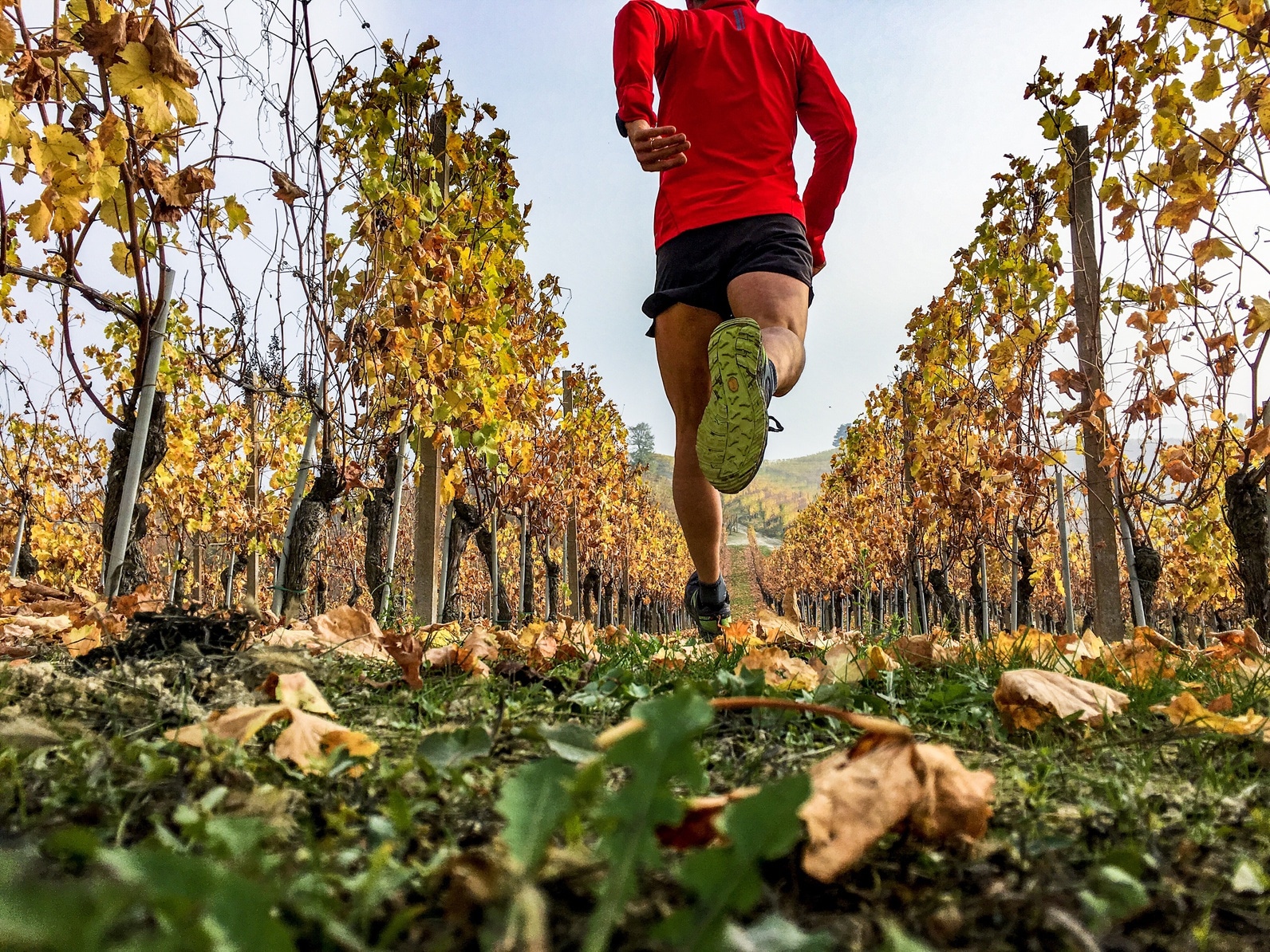
In my experience, the fastest way to get started with trail training is to hook up with a local group of trail runners and run with them. In most cases, these trail junkies are a wealth of info and can show you the best trails in your region and provide you with the guidance you need to start on the right foot.
Also, joining a running club can help pinpoint your own weaknesses and where you are falling short when it comes to trail running, whether it’s endurance, technical terrain running form, footwork, climbing hills, downhill runs, and so on.
This is one of the things I love about running. It’s a never-ending learning process. Once you get good at one thing, there is always something else you can work to improve on. And so on
So look up trail running groups in your area and also look them up in your city’s running club.
If you couldn’t locate any group, you can always head to the American Trail Running Associate website to tap into their free directory of U.S and international trails.
10. Prioritize Safety
The whole experience of trail running is about living (and running) on the edge—both literally and figuratively. Nonetheless, when it comes safety, it should never be ignored or brushed to the side.
The fact is, safety is way more important than trail workout times and achievements. You just can’t put your own life in peril just for the sake of achieving some trail running goal.
To stay safe, do the following:
Say something. Tell someone—a family member, a friend, a neighbor, you name it—where you are going and let them know where you are going and when they should expect to hear back from you.
Cell phones & maps. Bring your cell phone, and learn how to a map and a compass —in the event you got lost. Of course, most phones today are equipped with a GPS system, but you should keep in mind there may no signal outside city limits. You can find detailed maps in hiking stores, so use them and familiarize yourself with them.
Be identifiable. Bring with you your ID, and a list of emergency contact—in the off chance something bad happens to you, God forbid.
Run distraction free. Leave your headphones at home so you can keep your ears on your surroundings. And remember to enjoy the pristine the sights and sounds of the natural world—without letting them distract you from the task at hand.
If you easily get bored and want to keep your mind busy, then try listening to an audiobook or a podcast that will not only keep you engaged but maybe will also help you learn something new in the process.
Stay on the mark. Keep your runs on marked trails as often as possible, and don’t afraid of running right through a stream—getting your feet wet is part and parcel of the trail running experience.
Run with others. There is safety in numbers, to do your best to schedule your trails runs with a training buddy or a running group.
Beware of animals. Familiarize yourself with the type of wildlife in your area, and know what to do when you come face to face with a bear, a mountain lion, a snake, or any other dangerous animals.
Protect yourself. You can always bring with you a pepper spray if you are running alone and safety is an issue. Also, feel free to download and use safety apps for your phone, such as Road ID and bSafe.
Bring energy. For long trail runs, make sure to bring with you water and some food and fuel.
Be visible. Put on headlamp or flashlight if you are planning to run when it’s dark.
Keeps your eyes open. And most importantly, be mindful of your surroundings. Use common sense. Listen to your gut and never ignore those ancient gut feelings.
Of course, these safety principles are the common-sense stuff. Nevertheless, please don’t ignore them.
For more safety tips, check my running safety guide.
11. Practice Good Trail etiquette
Yes, the trails have their own etiquettes too, and you need to abide by it if you are serious about keeping it safe, and civilized.
Here are a few helpful hints to help you develop good trail etiquette (and not look like a complete a$$hole):
Yield to other trail users, whether they are runners, mountain bikers, equestrians or hikers. And stay to the right section of the trail. Plus, make way if you hear someone is coming up behind on a narrow, single track.
Be conscious of other trail users—mainly bikers, trekkers, horse riders, and other runners—and loudly call out “Passing on your right (or left)” when approaching them from behind to avoid startling them and/or taking them off guard
Keep distance. Maintain a healthy distance of at least 10 feet from other runners if you are running with a group. This is going to help you better see the ground ahead of you.
Be friendly. This is what good etiquette is all about. Smile, be of help and be happy about being able to share the great outdoors with other outdoor junkies.
Be a positive influence and contribute to the community, and try to build it and expand it, even if it’s just with a smile, a node or a few short friendly words.
Featured Image Credit – Sabastian Launay via Flickr
Original article and pictures take www.runnersblueprint.com site
Комментариев нет:
Отправить комментарий